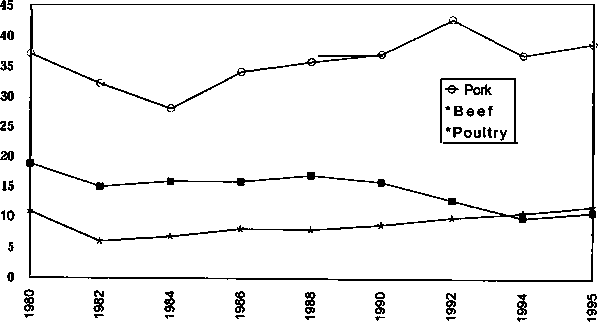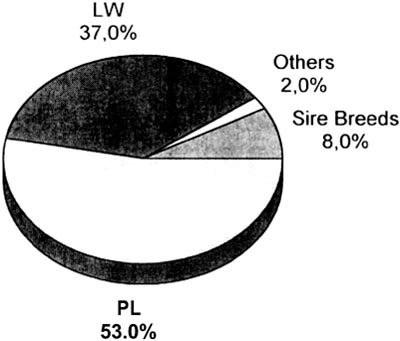D. Krencik, J. Dawidek
Central Animal Breeding Office, Warsaw, Poland
Cattle breeding and production activities
During the last few years one could observe a decreasing tendency in Polish cattle breeding. The number of cattle dropped dramatically from 10 million head in 1990 to 7.3 million in 1995 (it is only 55 % of the cattle number in 1975). During the same period the population of cows dropped from 4.9 million to 3.6 million. This tendency is still observed.
Table 1. Cattle in Poland (thousands of head)
|
Year |
Number of cattle |
Number of cows |
Number of cows in milk |
|
1975 |
13 254 |
6 146 |
759 |
|
1980 |
12 649 |
5 956 |
1 058 |
|
1985 |
11 055 |
5 528 |
1 023 |
|
1990 |
10 048 |
4 919 |
620 |
|
1995 |
7 695 |
3 578 |
352* |
* in 1994
The main reasons for this situation have been both the political and economic changes. The factors which have caused this tendency in cattle breeding in Poland are:
- a difficult economic situation in the dairy industry;
- lasting ownership changes, which lead often to the liquidation of whole cattle herds;
- increasing costs of breeding, and the very high costs of grains and protein concentrates, compared to the price of milk.
Most of the cattle in Poland are dairy cattle. For many years Polish farmers have kept dual purpose cattle, mostly Black and White. But during the last few years they began to use Holstein Friesian bulls to increase milk production. Unfortunately, milk production per cow in Poland is still very low and in 1995 production forecast for all cows was 3,130 kg. Milk production per recorded cow was 4,200 kg in 1994.
In beef cattle breeding the situation is different. The number of beef cattle has increased very much during the last year. Still it is not high but at the end of October 1995 were 2 300 beef breed cows were recorded, whereas in January 1995 they were 1 100. This tendency will continue, because farmers have bought many beef heifers.
Changes in milk and beef production developed in a way a little bit different from those in the cattle population (Table 2). First, milk and beef productions were growing to 1989 and 1990 respectively and then have started decreasing.
Most of the amounts of beef and milk produced are sold on the market. Only about 6 % of beef and 30 % of milk production are used by farmers for own need.
Data recording in Poland is being operated by the State which is represented by the Central Animal Breeding Office (CABO) and its Regional Offices (16).
Table 2. Milk and beef productions (million kg)
|
Year |
Milk production |
Beef production |
|
1988 |
15 200 |
1 365 |
|
1989 |
15 995 |
1 244 |
|
1990 |
15 382 |
1 428 |
|
1991 |
14 199 |
1 224 |
|
1992 |
12 770 |
944 |
|
1993 |
12 270 |
785 |
|
1994 |
11 866 |
717 |
|
1995 |
11 100* |
699* |
* forecast
Milk recording is carried out for all dairy breeds existing in Poland. Participation in the official milk recording is on a voluntary basis. Dairy cow recorded population represents 9% of the national herd. Most of the recorded cows are being kept in Black-and-White herds (93%). Till to 1995 all the cows were recorded according to A4 method. From that time herds which had been under control and had got less than five cows are covered with less frequent sampling and cheaper method - A8. (About 60 % of all recorded cows are in private farms. Excluding big farms from this number, it sets the average herd size in the private farms at 6.1 cows).
All recorded herds are controlled as regards fat and protein contents; however, successively other analysis like the number of somatic cells or the number of bacteria were included.
Breeders receive basic information concerning their cows in monthly and yearly reports.
Data from milk recording are collected in the computer center provided by a separate organization and are used for the estimation of breeding value.
Animal evaluation is calculated twice a year. Sire breeding value is calculated using the BLUP animal model method: only records of the first lactation are used for evaluation, the basis is the average cow born in 1990. Cow breeding value is evaluated by means of selection index procedure.
In 1996 the animal model evaluation based on first lactation records will be changed into a multi trait animal model. Probably the first three lactation will be used for evaluation. Then, breeding value for bulls and cows will be evaluated by the same method.
For the time being, no index combining milk production traits has been established in Poland.
One official progeny testing and selection program exists in Poland although each one of the 9 A.I. studs makes its own modification to adapt to particular environment. In Poland 3 80 young sires were tested in 1994. The young bulls enter an A.I. stud at 12- 15 months of age and after six months their semen should be distributed for progeny testing. However, the decreasing number of registered cows causes semen of some bulls to wait longer for distribution. Four hundred inseminations are foreseen for testing each bull within four months.
All recorded cows in Poland can be used for progeny testing of young sires. Till now, dairy farmers have not been required to use young sires in their herd - a system of states subsidies helps sampling young bulls. The first lactation of young bulls’ daughters begin on average at 29.5 months. Young bulls get their first official genetic evaluation at about seven years of age.
Apart from the official progeny testing program, some bulls are tested under a MOET scheme. In 1994 first 43 bulls received their initial genetic evaluation under this scheme and next 57 in 1995.
2.2 million cows are serviced by A.I. In this number, 0.44 million are mated with beef bulls and 0.15 million with progeny test bulls. The rest are mated with proven bulls including by means of imported semen. Imported semen currently accounts for less than 3 % of the matings although it does play an important role in the breeding of young bulls for entry into progeny testing.
Pig *breeding and production aspects
The transformation of economy in Poland and new economic reality caused pig breeders and producers to take different market demands into consideration. They should also introduce on improve technology to get better quality products. Now the main problem is the pig production structure, table 3 refers.
Table 3. Farms engaged in pig production (%)
|
Total number of private farms |
Number of pigs |
||||||
|
< 10 |
11-20 |
21-50 |
51-100 |
101-200 |
201-300 |
> 300 |
|
|
2 047 553 |
18.9 |
18.7 |
28.1 |
16.9 |
9.1 |
2.4 |
5.9 |
This structure should evolve and show. in connection with a concentration process, a modification of the number of pigs on the farms and a reduction of the number of farms. Furthermore it is a process which will take place anywhere and from ten to twenty years. This transformation will be supported by the EUROP classification system which will be introduced in Poland this year.
The economic position of livestock in the farming system
For the majority of farms animal production receipts account for 35 - 55 % of the overall profits; however on the farms specialized in pig production the receipts may reach a level of 75 - 90 %.
Trends in demand for trade in livestock products and breeding stock
For the last two years pig production (table 4) and the supply of animal goods to the market have been growing up.
The result of price stabilization and of production profitability. Also the differences between export and import levels have systematically decreased (table 5).
Table 4. Pig production (million kg)
|
Years and month |
||||
|
1994 |
1995 |
1996* |
||
|
I - VI |
VII - XII |
I-VI |
VII - XII |
I - VI |
|
1090 |
1136 |
1211 |
1230 |
1240 |
* prognosis
Table 5. Pork export and import proportion (million kg)
|
|
1991 |
1992 |
1993 |
1994 |
1995* |
|
Export |
32 |
20 |
20 |
33 |
50 |
|
Import |
72 |
44 |
55 |
115 |
60 |
In Poland traditionally pork is still the most popular meat (figure 1), however, in the future beef and poultry will come into prominence.
Figure 1. Meat consumption (kg/head)

Production of Breeding stock is connected with actual market situation. In the last year 40,000 boars and 89,000 gilts were sold. From this number of boars 15 % of the animals were issued from crossing sire breeds or lines. This tendency will probably develop in the future. It is related to changes in the technology of pig production and also it is stimulated by the prospect of introducing the EUROP classification system.
Breeding objectives and performance testing schemes
Sows breeding population depends on three elements:
- breeding program;
- progeny selection intensity level;
- market request for breeding stock.
Figure 2. Sow breeding population

The main breeding goals are achieved on the base results of particular kind of performance:
- reproductive performance;
- on-farm-test;
- results on testing stations.
Since 1 st April 1995 on-farm test index was modified through introducing - apart from daily gain - meat percentage in the carcass. This trait is estimated on the live animal.
On-farm test performance was carry out in all breeding herds while test at the control stations contain refers only to a top nucleus herd. Yearly 55,000 boars are tested at the farms and 280 sires are tested at the control stations.
Breeding value estimation and breeding programs
The main goal of breeding programs is genetic progress and its transmission to pig production population.
The proper program realization depends on:
- fulfilling accepted selection criteria;
- improving the method of breeding value estimation.
In Polish breeding program selection intensity is:
- 5 % for boars intended for natural matings and
- 0.5 % for boars intended for the AI stations.
Breeding value is estimated on the basis of the on-farm and control station phenotypic indexes. Since two years the herd breeding value is estimated by applying the BLUP method. This year BLUP will be used on regional level and next year this method will be introduced in the whole country.